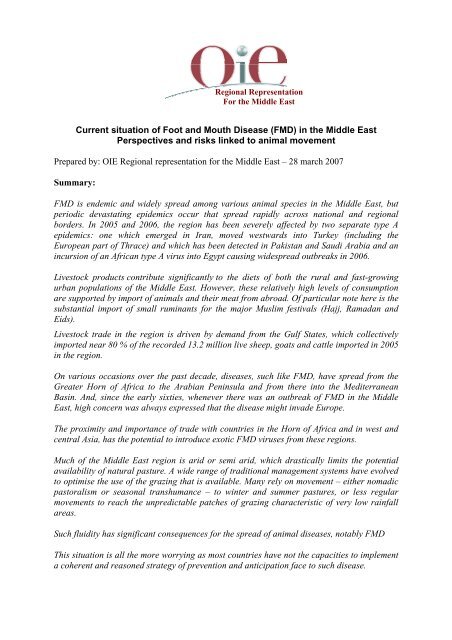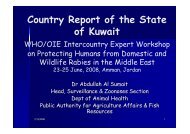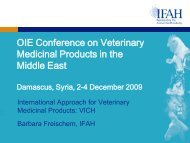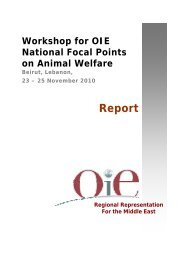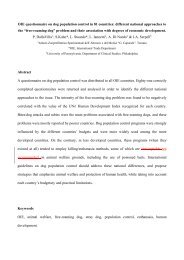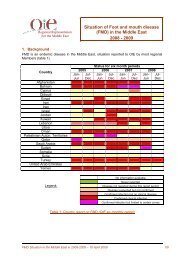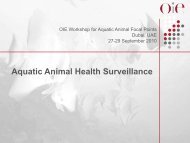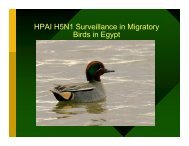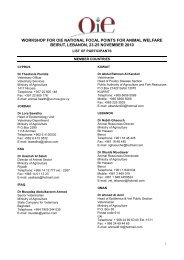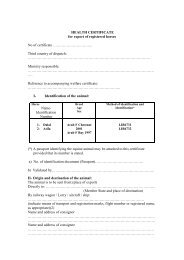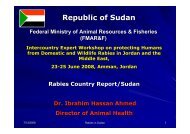FMD in the ME: Perspectives and risks linked to ... - Middle East - OIE
FMD in the ME: Perspectives and risks linked to ... - Middle East - OIE
FMD in the ME: Perspectives and risks linked to ... - Middle East - OIE
You also want an ePaper? Increase the reach of your titles
YUMPU automatically turns print PDFs into web optimized ePapers that Google loves.
Regional RepresentationFor <strong>the</strong> <strong>Middle</strong> <strong>East</strong>Current situation of Foot <strong>and</strong> Mouth Disease (<strong>FMD</strong>) <strong>in</strong> <strong>the</strong> <strong>Middle</strong> <strong>East</strong><strong>Perspectives</strong> <strong>and</strong> <strong>risks</strong> l<strong>in</strong>ked <strong>to</strong> animal movementPrepared by: <strong>OIE</strong> Regional representation for <strong>the</strong> <strong>Middle</strong> <strong>East</strong> – 28 march 2007Summary:<strong>FMD</strong> is endemic <strong>and</strong> widely spread among various animal species <strong>in</strong> <strong>the</strong> <strong>Middle</strong> <strong>East</strong>, butperiodic devastat<strong>in</strong>g epidemics occur that spread rapidly across national <strong>and</strong> regionalborders. In 2005 <strong>and</strong> 2006, <strong>the</strong> region has been severely affected by two separate type Aepidemics: one which emerged <strong>in</strong> Iran, moved westwards <strong>in</strong><strong>to</strong> Turkey (<strong>in</strong>clud<strong>in</strong>g <strong>the</strong>European part of Thrace) <strong>and</strong> which has been detected <strong>in</strong> Pakistan <strong>and</strong> Saudi Arabia <strong>and</strong> an<strong>in</strong>cursion of an African type A virus <strong>in</strong><strong>to</strong> Egypt caus<strong>in</strong>g widespread outbreaks <strong>in</strong> 2006.Lives<strong>to</strong>ck products contribute significantly <strong>to</strong> <strong>the</strong> diets of both <strong>the</strong> rural <strong>and</strong> fast-grow<strong>in</strong>gurban populations of <strong>the</strong> <strong>Middle</strong> <strong>East</strong>. However, <strong>the</strong>se relatively high levels of consumptionare supported by import of animals <strong>and</strong> <strong>the</strong>ir meat from abroad. Of particular note here is <strong>the</strong>substantial import of small rum<strong>in</strong>ants for <strong>the</strong> major Muslim festivals (Hajj, Ramadan <strong>and</strong>Eids).Lives<strong>to</strong>ck trade <strong>in</strong> <strong>the</strong> region is driven by dem<strong>and</strong> from <strong>the</strong> Gulf States, which collectivelyimported near 80 % of <strong>the</strong> recorded 13.2 million live sheep, goats <strong>and</strong> cattle imported <strong>in</strong> 2005<strong>in</strong> <strong>the</strong> region.On various occasions over <strong>the</strong> past decade, diseases, such like <strong>FMD</strong>, have spread from <strong>the</strong>Greater Horn of Africa <strong>to</strong> <strong>the</strong> Arabian Pen<strong>in</strong>sula <strong>and</strong> from <strong>the</strong>re <strong>in</strong><strong>to</strong> <strong>the</strong> MediterraneanBas<strong>in</strong>. And, s<strong>in</strong>ce <strong>the</strong> early sixties, whenever <strong>the</strong>re was an outbreak of <strong>FMD</strong> <strong>in</strong> <strong>the</strong> <strong>Middle</strong><strong>East</strong>, high concern was always expressed that <strong>the</strong> disease might <strong>in</strong>vade Europe.The proximity <strong>and</strong> importance of trade with countries <strong>in</strong> <strong>the</strong> Horn of Africa <strong>and</strong> <strong>in</strong> west <strong>and</strong>central Asia, has <strong>the</strong> potential <strong>to</strong> <strong>in</strong>troduce exotic <strong>FMD</strong> viruses from <strong>the</strong>se regions.Much of <strong>the</strong> <strong>Middle</strong> <strong>East</strong> region is arid or semi arid, which drastically limits <strong>the</strong> potentialavailability of natural pasture. A wide range of traditional management systems have evolved<strong>to</strong> optimise <strong>the</strong> use of <strong>the</strong> graz<strong>in</strong>g that is available. Many rely on movement – ei<strong>the</strong>r nomadicpas<strong>to</strong>ralism or seasonal transhumance – <strong>to</strong> w<strong>in</strong>ter <strong>and</strong> summer pastures, or less regularmovements <strong>to</strong> reach <strong>the</strong> unpredictable patches of graz<strong>in</strong>g characteristic of very low ra<strong>in</strong>fallareas.Such fluidity has significant consequences for <strong>the</strong> spread of animal diseases, notably <strong>FMD</strong>This situation is all <strong>the</strong> more worry<strong>in</strong>g as most countries have not <strong>the</strong> capacities <strong>to</strong> implementa coherent <strong>and</strong> reasoned strategy of prevention <strong>and</strong> anticipation face <strong>to</strong> such disease.
2Indeed, regard<strong>in</strong>g absence <strong>in</strong> most countries of biosecurity measures, <strong>in</strong>volv<strong>in</strong>g strict bordercontrol, early detection program for new stra<strong>in</strong>s, confidence <strong>in</strong> analyses realised by <strong>the</strong>national labs, epidemiological survey, vacc<strong>in</strong>ation moni<strong>to</strong>r<strong>in</strong>g, cont<strong>in</strong>gency plans….are asmany fac<strong>to</strong>rs promot<strong>in</strong>g <strong>the</strong> spread of <strong>the</strong> disease, notably <strong>the</strong> epidemic form.Unfortunately, due <strong>to</strong> <strong>the</strong> import<strong>in</strong>g capacity of <strong>the</strong> <strong>Middle</strong> <strong>East</strong>, <strong>the</strong> region was left beh<strong>in</strong>d<strong>the</strong> major <strong>in</strong>ternational animal health programs that were elaborated for <strong>the</strong> control of majortransboundary animal diseases <strong>in</strong>clud<strong>in</strong>g <strong>FMD</strong>. Countries of <strong>the</strong> <strong>Middle</strong> <strong>East</strong> were<strong>in</strong>dividually <strong>in</strong>volved <strong>in</strong> different programs of o<strong>the</strong>r regions which led <strong>to</strong> more mistreatmen<strong>to</strong>f <strong>the</strong> region as a unique <strong>and</strong> <strong>in</strong>tegrated epidemiological block.Thus, <strong>to</strong> control <strong>FMD</strong> worldwide, <strong>the</strong> situation of this disease <strong>in</strong> <strong>Middle</strong> <strong>East</strong>ern countriesshould be treated as a priority.So, <strong>the</strong> implementation of a regional project <strong>to</strong> control <strong>FMD</strong> <strong>in</strong> <strong>the</strong> <strong>Middle</strong> <strong>East</strong> is essential.This was highlighted dur<strong>in</strong>g <strong>the</strong> 3 rd Roundtable Meet<strong>in</strong>g on <strong>FMD</strong> control <strong>in</strong> <strong>the</strong> <strong>Middle</strong> <strong>East</strong><strong>and</strong> North Africa, Damascus, Syria, November 6-7 th 2006, where one of <strong>the</strong> majorrecommendation made is <strong>to</strong> implement such project with<strong>in</strong> <strong>the</strong> <strong>OIE</strong>/FAO global framework of<strong>the</strong> progressive control of transboundary animal disease program (GF-TADs) <strong>and</strong> cocoord<strong>in</strong>atedby <strong>the</strong> Regional Animal Health Centre (RAHC) established <strong>to</strong> provide expertise<strong>and</strong> assistance especially <strong>in</strong> major emergency cases <strong>in</strong> <strong>the</strong> region.______________________________________The <strong>Middle</strong> <strong>East</strong> region is act<strong>in</strong>g as a mix<strong>in</strong>g vessel <strong>to</strong> animals from different sources <strong>in</strong><strong>the</strong> world. As an important import<strong>in</strong>g region, <strong>the</strong> <strong>Middle</strong> <strong>East</strong> receives animals <strong>and</strong> animalproducts from different parts of <strong>the</strong> world <strong>and</strong> mostly from regions where <strong>FMD</strong> is endemic.The <strong>in</strong>effective <strong>in</strong>frastructure of <strong>the</strong> veter<strong>in</strong>ary quarant<strong>in</strong>e bodies <strong>and</strong> <strong>the</strong> lack of appropriatediagnostic capabilities always lead <strong>to</strong> <strong>the</strong> absence of any early warn<strong>in</strong>g system. The numberof under-tra<strong>in</strong>ed veter<strong>in</strong>ary personnel compared with <strong>the</strong> professional veter<strong>in</strong>arians <strong>in</strong>-chargeof disease surveillance <strong>and</strong> moni<strong>to</strong>r<strong>in</strong>g of animal diseases especially <strong>FMD</strong> makes it difficult<strong>to</strong> achieve proper control of <strong>the</strong> disease.The lack of <strong>in</strong>formation exchange among countries of <strong>the</strong> regions <strong>and</strong> <strong>the</strong> uncontrolledimportation of veter<strong>in</strong>ary biologicals <strong>and</strong> vacc<strong>in</strong>es as well as <strong>the</strong> absence of proper qualitycontrol add <strong>to</strong> <strong>the</strong> risk fac<strong>to</strong>rs of more <strong>in</strong>troduction of <strong>the</strong> disease <strong>to</strong> <strong>the</strong> region <strong>and</strong> morethreat <strong>to</strong> <strong>the</strong> neighbor<strong>in</strong>g ones.As an air-borne disease, <strong>the</strong> potential of <strong>the</strong> spread of <strong>the</strong> disease <strong>to</strong> adjacent regions is<strong>in</strong>creas<strong>in</strong>gly considered consider<strong>in</strong>g <strong>the</strong> geographical location of <strong>the</strong> <strong>Middle</strong> <strong>East</strong> <strong>and</strong> <strong>the</strong><strong>in</strong>creas<strong>in</strong>g traffic <strong>and</strong> transportation of people <strong>and</strong> goods <strong>to</strong> <strong>and</strong> from <strong>the</strong> region. The ports of<strong>the</strong> <strong>Middle</strong> <strong>East</strong> <strong>and</strong> escalat<strong>in</strong>g volume of shipments <strong>and</strong> transit sec<strong>to</strong>r are o<strong>the</strong>r <strong>in</strong>direct <strong>and</strong>unforeseen threats.Unfortunately, due <strong>to</strong> <strong>the</strong> import<strong>in</strong>g capacity of <strong>the</strong> <strong>Middle</strong> <strong>East</strong>, <strong>the</strong> region was left beh<strong>in</strong>d<strong>the</strong> major <strong>in</strong>ternational animal health programs that were elaborated for <strong>the</strong> control ofmajor transboundary animal diseases <strong>in</strong>clud<strong>in</strong>g <strong>FMD</strong>. Countries of <strong>the</strong> <strong>Middle</strong> <strong>East</strong> were<strong>in</strong>dividually <strong>in</strong>volved <strong>in</strong> different programs of o<strong>the</strong>r regions which led <strong>to</strong> more mistreatmen<strong>to</strong>f <strong>the</strong> region as a unique <strong>and</strong> <strong>in</strong>tegrated epidemiological block.
3The last epidemics of <strong>FMD</strong> <strong>in</strong> Europe suggest that <strong>the</strong> disease may take a sudden <strong>and</strong> a strongcomeback <strong>in</strong> any region. The effective control or eradication of <strong>the</strong> disease cannot beachieved with isolated country efforts, especially <strong>in</strong> those hav<strong>in</strong>g common borders withseveral countries <strong>and</strong> <strong>in</strong> which veter<strong>in</strong>ary practices differ. Concreted efforts of countries <strong>in</strong> <strong>the</strong>region are, <strong>the</strong>refore, required <strong>to</strong> curb such an important disease. This stems from <strong>the</strong> fact that<strong>the</strong> spread of this disease <strong>in</strong> <strong>the</strong> region negatively affects <strong>the</strong> Inter-Arab agricultural tradebecause of <strong>the</strong> str<strong>in</strong>gent measures enforced by several countries. The situation becomes morecritical after <strong>the</strong> recent establishment of <strong>the</strong> World Trade Organization (WTO) <strong>and</strong> <strong>the</strong>necessity of implementation of <strong>the</strong> guidel<strong>in</strong>es <strong>and</strong> st<strong>and</strong>ards of <strong>the</strong> <strong>OIE</strong>.1. Summary of <strong>the</strong> Foot <strong>and</strong> Mouth Disease <strong>in</strong> <strong>the</strong> <strong>Middle</strong> <strong>East</strong>1.1. Current situation<strong>FMD</strong> rema<strong>in</strong>s a significant dra<strong>in</strong> on <strong>the</strong> budgets of <strong>the</strong> national veter<strong>in</strong>ary services of <strong>the</strong><strong>Middle</strong> <strong>East</strong> countries <strong>and</strong> on <strong>the</strong> livelihoods of lives<strong>to</strong>ck owners across <strong>the</strong> region. Asfrom a national po<strong>in</strong>t of view, where control measures are rigorously applied, <strong>the</strong> disease<strong>in</strong>volves heavy expenditure on diagnostic services, campaign of vacc<strong>in</strong>ation, stamp<strong>in</strong>g outpolicy, quarant<strong>in</strong>e <strong>and</strong> carcass disposal measures.The disease is endemic, but periodic devastat<strong>in</strong>g epidemics occur that spread rapidlyacross national <strong>and</strong> regional borders.<strong>FMD</strong> cont<strong>in</strong>ues <strong>to</strong> limit <strong>the</strong> development of dairy <strong>in</strong>dustry <strong>in</strong> most of <strong>the</strong> <strong>Middle</strong> <strong>East</strong>countries, caus<strong>in</strong>g economic losses through decrease of milk <strong>and</strong> beef cattle production,<strong>and</strong> high mortality <strong>in</strong> young rum<strong>in</strong>ants.Although not quantified, <strong>the</strong> <strong>in</strong>cidence <strong>and</strong> importance of <strong>FMD</strong> <strong>in</strong> small rum<strong>in</strong>ants <strong>in</strong> <strong>the</strong>region is on <strong>the</strong> rise. Indirectly, <strong>FMD</strong> may be a predispos<strong>in</strong>g fac<strong>to</strong>r <strong>to</strong> o<strong>the</strong>r microbial<strong>and</strong>/or nutritional diseases that lead <strong>to</strong> economic losses <strong>in</strong> <strong>the</strong>se species.In 2005 <strong>and</strong> 2006, <strong>the</strong> <strong>Middle</strong> <strong>East</strong> has been severely affected by two separate type Aepidemics, one which emerged <strong>in</strong> Iran (A Iran 05) <strong>in</strong> 2005- 2006, <strong>and</strong> an <strong>in</strong>cursion of anAfrican type A virus <strong>in</strong><strong>to</strong> Egypt caus<strong>in</strong>g widespread outbreaks <strong>in</strong> January-July 2006 (mapn°1).The new serotype A virus (A Iran 2005) was first observed <strong>in</strong> Iran <strong>and</strong> moved westwards<strong>in</strong><strong>to</strong> Turkey (<strong>in</strong>clud<strong>in</strong>g <strong>the</strong> European part of Thrace). It has cont<strong>in</strong>ued <strong>to</strong> spread <strong>in</strong>2006, circulat<strong>in</strong>g <strong>in</strong> Turkey <strong>and</strong> Iran, <strong>and</strong> which has been detected <strong>in</strong> Pakistan <strong>and</strong> SaudiArabia.In Turkey <strong>and</strong> Iran, <strong>the</strong> type A vacc<strong>in</strong>es <strong>in</strong> rout<strong>in</strong>e use did not prevent <strong>the</strong> new stra<strong>in</strong>from spread<strong>in</strong>g.Phlylogenetic analyses revealed that <strong>the</strong> stra<strong>in</strong> A Iran 2005 isolates from Iran, Turkey,Pakistan <strong>and</strong> Saudi Arabia formed a s<strong>in</strong>gle genetic l<strong>in</strong>eage dist<strong>in</strong>ct from previous virusstra<strong>in</strong>s present <strong>in</strong> <strong>the</strong> region, <strong>in</strong>clud<strong>in</strong>g A-Iran-96 <strong>and</strong> A-Iran-99. Vacc<strong>in</strong>e match<strong>in</strong>g testsrevealed this new l<strong>in</strong>eage <strong>to</strong> be antigenically more like A 22 .The type A which affected Egypt, was diagnosed <strong>in</strong> 8 governorates <strong>in</strong> this country.Genetically, this new serotype A differs considerably from <strong>the</strong> <strong>Middle</strong> <strong>East</strong>ern viruses <strong>and</strong>
4was closely related <strong>to</strong> <strong>FMD</strong> viruses from <strong>East</strong> Africa. Antigenically, a vacc<strong>in</strong>e<strong>in</strong>corporat<strong>in</strong>g A-Eritrea-98 would be expected <strong>to</strong> afford protection.The lack of immediate vacc<strong>in</strong>es aga<strong>in</strong>st <strong>the</strong> A Iran 05 <strong>and</strong> A Egypt 06 viruses contributed<strong>to</strong> <strong>the</strong> large scale of <strong>the</strong> outbreaks.In both of <strong>the</strong>se events, <strong>the</strong> virus behaved essentially as if it were enter<strong>in</strong>g a naïvepopulation with no immunity, <strong>and</strong> <strong>in</strong> both Turkey <strong>and</strong> Egypt, with<strong>in</strong> 2 or 3 months of <strong>the</strong><strong>in</strong>dex case, had spread almost of <strong>the</strong> extent of <strong>the</strong> cattle distribution.In both case, <strong>the</strong> majority of geographical spread with<strong>in</strong> <strong>the</strong> countries had occurred beforenotification of <strong>the</strong> <strong>in</strong>dex case <strong>to</strong> <strong>the</strong> <strong>OIE</strong>.Type O rema<strong>in</strong>s endemic, but <strong>the</strong> risk of Asia-1 appears dim<strong>in</strong>ished with <strong>the</strong> last reportedoccurrence <strong>in</strong> Iran <strong>in</strong> August 2005. SAT viruses have not been reported <strong>in</strong> <strong>the</strong> region s<strong>in</strong>ce2003 (SAT-1 <strong>in</strong> Libya), but serological evidence of SAT <strong>in</strong>fection <strong>in</strong> Sudan waspresented.Almost all countries operate vacc<strong>in</strong>ation programs <strong>in</strong> large rum<strong>in</strong>ants, some <strong>in</strong> allrum<strong>in</strong>ant species. These vacc<strong>in</strong>ation programs utilise vacc<strong>in</strong>es from a wide variety ofsources, <strong>in</strong>clud<strong>in</strong>g producers based with<strong>in</strong> <strong>the</strong> region <strong>and</strong> <strong>in</strong>ternational suppliers fromEurope <strong>and</strong> India. The lack of st<strong>and</strong>ardisation may be a fac<strong>to</strong>r affect<strong>in</strong>g control.Map n°1: recent spread of Iran 05 <strong>and</strong> A serotypes <strong>to</strong> <strong>the</strong> region
5The table below summarize <strong>the</strong> <strong>FMD</strong> situation <strong>in</strong> <strong>the</strong> <strong>Middle</strong> <strong>East</strong>ern countries, accord<strong>in</strong>g<strong>to</strong> countries reports presented at <strong>the</strong> 3 rd Roundtable Meet<strong>in</strong>g on <strong>FMD</strong> control <strong>in</strong> <strong>the</strong><strong>Middle</strong> <strong>East</strong> <strong>and</strong> North Africa, Damascus, Syria, November 6-7 th 2006.Country Bahreïn Cyprus Djibouti Egypt Iran Iraq JordanStatut + 1964 2001 + + + 1999Type O - - A A, O, Asia 1 A, O -Country Kuwait Lebanon Libya OmanPalest<strong>in</strong>ianTerri<strong>to</strong>riesQatarSaoudiArabiaStatut + + 2003 + + + +Type O O - O O O A, OCountry Sudan Syria TurkeyUnited ArabEmiratesYemenStatut 2005 (?) 2002 + + +Type - - A, O, Asia 1 O O+ : presence- : not detected1994 : last outbreak occurence1.2. <strong>FMD</strong> hazards identified <strong>in</strong> <strong>the</strong> RegionThe major routes of <strong>the</strong> <strong>FMD</strong> <strong>in</strong>fection <strong>in</strong> <strong>the</strong> region are:• From outside <strong>the</strong> <strong>Middle</strong> <strong>East</strong> Region:The <strong>Middle</strong> <strong>East</strong> is surrounded by some o<strong>the</strong>r <strong>FMD</strong> <strong>in</strong>fected areas such as Caucasiancountries, <strong>East</strong>ern <strong>and</strong> Western Africa <strong>and</strong> South Asia. The region is an importantlives<strong>to</strong>ck import market without effective pre-import <strong>and</strong> quarant<strong>in</strong>e measures. Thesecond reason is <strong>the</strong> uncontrolled movement of animals across borders.The spread of <strong>FMD</strong> stra<strong>in</strong>s exotic <strong>to</strong> <strong>the</strong> <strong>Middle</strong> <strong>East</strong> Region has been identified: <strong>East</strong> Africa. Asian stra<strong>in</strong>s. South America due <strong>to</strong> imports. O<strong>the</strong>r regions due <strong>to</strong> means of transportation <strong>and</strong> trade routes pass<strong>in</strong>g through <strong>the</strong><strong>Middle</strong> east due <strong>to</strong> its geographic location at <strong>the</strong> cross-roads of <strong>the</strong> old world.
• From <strong>in</strong>side <strong>the</strong> <strong>Middle</strong> <strong>East</strong> Region:6Movement of animals with<strong>in</strong> <strong>the</strong> Region is ma<strong>in</strong>ly governed by <strong>the</strong> characteristics of <strong>the</strong>animal population. The <strong>Middle</strong> <strong>East</strong> Region is characterized by <strong>the</strong> quasi-absence of pigs<strong>and</strong> <strong>the</strong> importance of small rum<strong>in</strong>ants (443 million vs. 137 million cattle <strong>and</strong> buffaloes).The agro-pas<strong>to</strong>ral system is predom<strong>in</strong>ant, which implies much lives<strong>to</strong>ck movement due <strong>to</strong>transhumance, drought or attraction of markets. Religious festivals <strong>and</strong> Islamic charity arealso favor<strong>in</strong>g lives<strong>to</strong>ck movement.2. Lives<strong>to</strong>ck population <strong>in</strong> <strong>the</strong> <strong>Middle</strong> <strong>East</strong>ern countriesMany countries <strong>in</strong> <strong>the</strong> <strong>Middle</strong> <strong>East</strong> have huge rum<strong>in</strong>ant lives<strong>to</strong>ck resources, provid<strong>in</strong>glivelihood <strong>and</strong> employment <strong>to</strong> a high proportion of <strong>the</strong>ir populations <strong>and</strong> earn valuable foreignexchanger <strong>to</strong> <strong>the</strong> nation.The <strong>Middle</strong> <strong>East</strong>ern countries have considerable animal populations. The lives<strong>to</strong>ck sec<strong>to</strong>r, <strong>in</strong>particular sheep <strong>and</strong> goats, plays an important role <strong>in</strong> <strong>the</strong> national economy of <strong>the</strong> Regioncountries. The percentage of <strong>the</strong> Gross National Product (GNP) generated from agriculture <strong>in</strong><strong>the</strong> high-<strong>in</strong>come countries of <strong>the</strong> Region varies from 1 <strong>to</strong> 4 percent <strong>and</strong> <strong>in</strong> <strong>the</strong> low-<strong>in</strong>comecountries varies from 23 <strong>to</strong> 55 percent 1 .The table below reports <strong>the</strong> animal population <strong>in</strong> <strong>the</strong> <strong>Middle</strong> <strong>East</strong>ern countries sensible <strong>to</strong><strong>FMD</strong>, <strong>in</strong> 2006, accord<strong>in</strong>g <strong>to</strong> countries reports presented at <strong>the</strong> 3 rd Roundtable Meet<strong>in</strong>g on<strong>FMD</strong> control <strong>in</strong> <strong>the</strong> <strong>Middle</strong> <strong>East</strong> <strong>and</strong> North Africa.1 FAO (2003) Lives<strong>to</strong>ck Dynamics <strong>in</strong> <strong>the</strong> Arabian Pen<strong>in</strong>sula. A Regional Review of National Lives<strong>to</strong>ckResources <strong>and</strong> International Lives<strong>to</strong>ck Trade. David Bourn, Environmental Research Group Oxford, UnitedK<strong>in</strong>gdom, consultant, January 2003, Rome.http://ergodd.zoo.ox.ac.uk/download/<strong>in</strong>dex.htm
7Country Cattles Sheeps Goats Camels BuffaloesBahra<strong>in</strong> 16 450 27 800 17 500 2 200 /Djibouti 55 000 400 000 550 000 30 000 /Egypt 2 531 200 2 602 650 1 329 500 149 500 2 234 000Jordan 59 750 1 933 400 461 400 19 000 /K<strong>in</strong>gdom ofSaudi Arabia300 000 1 300 000 6 300 000 800 000 /Kuwait 14 000 1 000 000 100 000 100 000 /Lebanon 85 000 350 000 450 000 / /Oman 230 640 233 000 882 600 104 700 /Palest<strong>in</strong>ianAuthorities11 200 540 000 248 500 / /Qatar 14 800 214 530 178 500 50 800 /Sudan 33 103 000 39 835 000 36 087 000 2 936 000 /Syria 930 000 13 800 000 1 100 000 8 800 1 300United ArabEmirates68 900 450 000 120 000 200 000 /Yemen 1 400 500 5 029 000 4 452 500 198 500 /The study of country declaration on <strong>the</strong>ir national lives<strong>to</strong>ck population 2 shows stability from<strong>the</strong> last 5 years, <strong>and</strong> this tendency could be extrapolated for <strong>the</strong> next 5 years.3. Lives<strong>to</strong>ck movement <strong>in</strong> <strong>the</strong> <strong>Middle</strong> <strong>East</strong>ern countriesMost countries do not have an appropriate system <strong>to</strong> collect, analyse <strong>and</strong> notify statistical dataon lives<strong>to</strong>ck <strong>and</strong> agricultural <strong>in</strong> general. Information on lives<strong>to</strong>ck available resources is oftennot complete or reliable.3.1. Import <strong>and</strong> exportLives<strong>to</strong>ck products contribute significantly <strong>to</strong> <strong>the</strong> diets of both <strong>the</strong> rural <strong>and</strong> fast-grow<strong>in</strong>gurban populations. However, <strong>the</strong>se relatively high levels of consumption are supported byimport of animals <strong>and</strong> <strong>the</strong>ir meat from abroad. Of particular note here is <strong>the</strong> substantialimport of small rum<strong>in</strong>ants for <strong>the</strong> major Muslim festivals (Hajj, Ramadan <strong>and</strong> Eids).2 <strong>OIE</strong>, World Animal Health situation <strong>in</strong> 2000 – 2001 – 2002, <strong>OIE</strong> publications : Bahra<strong>in</strong>, Egypt, Jordan,Kuwait, Lebanon, Qatar, Sudan; Syria
8Many millions of live rum<strong>in</strong>ants are imported <strong>in</strong><strong>to</strong> <strong>the</strong> <strong>Middle</strong> <strong>East</strong>ern countries each yearfrom around <strong>the</strong> world, <strong>in</strong>clud<strong>in</strong>g especially greater Horn of Africa countries, <strong>East</strong> Asia,Iran, Turkey, Europe, South America, Australia, <strong>and</strong> New Zeal<strong>and</strong> (Map n° 2). On variousoccasions over <strong>the</strong> past decade, diseases, such like <strong>FMD</strong>, have spread from <strong>the</strong> GreaterHorn of Africa <strong>to</strong> <strong>the</strong> Arabian Pen<strong>in</strong>sula <strong>and</strong> from <strong>the</strong>re <strong>in</strong><strong>to</strong> <strong>the</strong> Mediterranean Bas<strong>in</strong>.Lives<strong>to</strong>ck trade <strong>in</strong> <strong>the</strong> region is driven by dem<strong>and</strong> from <strong>the</strong> Gulf States (Bahra<strong>in</strong>, Kuwait,Oman, Qatar, Saudi Arabia <strong>and</strong> UAE), which collectively imported near 80 % of <strong>the</strong>recorded 13.2 million live sheep, goats <strong>and</strong> cattle imported <strong>in</strong> 2005 <strong>in</strong> <strong>the</strong> region.The table below reports <strong>the</strong> lives<strong>to</strong>ck imports (cattle, sheep, <strong>and</strong> goats) <strong>in</strong> 2005 <strong>in</strong> <strong>the</strong><strong>Middle</strong> <strong>East</strong>ern countries 3 .Country Cattles Sheeps GoatsBahra<strong>in</strong> 748 98 258 6 510Djibouti No data No data 450Egypt 18 571 2 294 No dataJordan 20 886 571 551 100 760K<strong>in</strong>gdom of SaudiArabia26 998 6 042 607 502 038Kuwait 4 908 1 898 399 32 455Lebanon 203 531 64 428 3 182Libya 2 013 10 592 25Oman 39 395 638 160 180Palest<strong>in</strong>ian Authorities 9 411 No data No dataQatar 829 559 546 45 334Sudan 2 No data No dataSyria 8 230 34 907 No dataUnited Arab Emirates 3 518 522 540 516 714Yemen 172 354 7 467 1 164 117Total 472 038 10 208 227 2 531 765For all countries <strong>and</strong> species, imports far exceed exports, except for sheep exports fromSyria (2 821 145 <strong>in</strong> 2005) <strong>and</strong> Sudan (1 147 028 <strong>in</strong> 2005), <strong>and</strong> <strong>the</strong>re is, <strong>the</strong>refore, a majornet <strong>in</strong>flow of lives<strong>to</strong>ck <strong>in</strong><strong>to</strong> <strong>the</strong> region.3 source FAOSTAT : http://faostat.fao.org
9In 2005, K<strong>in</strong>gdom of Saudi Arabia was by far <strong>the</strong> largest importer of live animals, with6.04 million sheep <strong>and</strong> 500 000 goats. Kuwait was <strong>the</strong> next largest sheep importer,followed by Jordan, Oman, UAE, Qatar <strong>and</strong> Bahra<strong>in</strong>.Sudan (122 000) <strong>and</strong> Oman (103 385) were <strong>the</strong> ma<strong>in</strong> exporter of live goats with 855,000recorded exports <strong>in</strong> 2005.More <strong>and</strong> more <strong>the</strong> supply from free <strong>FMD</strong> countries, notably for <strong>the</strong> Arabic Pen<strong>in</strong>sulacountries needs, is difficult l<strong>in</strong>ked <strong>to</strong> <strong>the</strong> cost of animals <strong>and</strong> transport (Australia, SouthAmerica) <strong>and</strong> <strong>to</strong> <strong>the</strong> <strong>in</strong>capacity <strong>to</strong> those countries <strong>to</strong> respond <strong>to</strong> such a dem<strong>and</strong>.Thus, <strong>the</strong> importation flow <strong>in</strong>volve <strong>the</strong> African Horn countries (Somalia, Sudan), where<strong>FMD</strong> is uncontrolled but where <strong>the</strong> production is sufficient with a competitive cost.Turkey <strong>and</strong> Iran represent also a significant source of sheep <strong>and</strong> goats for <strong>Middle</strong> <strong>East</strong>erncountries.Omniscient of <strong>the</strong> risk of such trade, <strong>the</strong> Arabic Pen<strong>in</strong>sula countries, wish <strong>to</strong> collaboratewith <strong>the</strong> African Horn countries <strong>to</strong> implement <strong>the</strong> security of such trade, notably with <strong>the</strong>build<strong>in</strong>g of Pre Export Quarant<strong>in</strong>e Station <strong>and</strong> upon sanitary certification elaborated <strong>in</strong> <strong>the</strong>respect of <strong>the</strong> <strong>OIE</strong>’s recommendations.Map n° 2: International trade <strong>in</strong> animals <strong>and</strong> animal products with <strong>the</strong> <strong>Middle</strong> <strong>East</strong>
3.2. lives<strong>to</strong>ck movement <strong>in</strong>volved by specific production systems10The <strong>Middle</strong> <strong>East</strong> has long been a focus of attention for animal health professionalsbecause it supports very large numbers of rum<strong>in</strong>ant lives<strong>to</strong>ck – especially sheep. Much of<strong>the</strong> region is arid or semi arid, which drastically limits <strong>the</strong> potential availability of naturalpasture. Much of <strong>the</strong> area cannot support graz<strong>in</strong>g for large parts of <strong>the</strong> year – because it is<strong>to</strong>o dry, <strong>to</strong>o cold, or is covered <strong>in</strong> deep snow.In an area that has been settled for longer than most o<strong>the</strong>r parts of <strong>the</strong> world, it is <strong>to</strong> beexpected that a wide range of traditional management systems have evolved <strong>to</strong> optimise<strong>the</strong> use of <strong>the</strong> graz<strong>in</strong>g that is available. Many rely on movement – ei<strong>the</strong>r nomadicpas<strong>to</strong>ralism or seasonal transhumance – <strong>to</strong> w<strong>in</strong>ter <strong>and</strong> summer pastures, or less regularmovements <strong>to</strong> reach <strong>the</strong> unpredictable patches of graz<strong>in</strong>g characteristic of very lowra<strong>in</strong>fall areas. Though <strong>the</strong>se are slowly giv<strong>in</strong>g way <strong>to</strong> more <strong>in</strong>tensive husb<strong>and</strong>rytechniques that rely on supplementary or stall feed<strong>in</strong>g, opportunism is still a widelypracticed strategy.The <strong>Middle</strong> <strong>East</strong> thus supports an unusually mobile lives<strong>to</strong>ck population (map n° 3), <strong>in</strong>areas with particularly variable graz<strong>in</strong>g distribution patterns. Add <strong>to</strong> this <strong>the</strong> fact that <strong>the</strong>reis a very large volume of <strong>in</strong>ternational trad<strong>in</strong>g, driven <strong>to</strong> a great extent by <strong>the</strong> dem<strong>and</strong> forsmall rum<strong>in</strong>ant meat from <strong>the</strong> Gulf States, <strong>and</strong> from <strong>the</strong> pilgrims <strong>to</strong> <strong>the</strong> annual religiousseason <strong>in</strong> Mecca. This draws animals from all <strong>the</strong> <strong>Middle</strong> <strong>East</strong>ern states, many gett<strong>in</strong>g<strong>the</strong>re by foot ra<strong>the</strong>r than mechanised transport.Such fluidity has significant consequences for <strong>the</strong> spread of animal diseases, both<strong>in</strong>fectious <strong>and</strong> vec<strong>to</strong>r borne. Though ra<strong>the</strong>r poorly unders<strong>to</strong>od, at least <strong>in</strong> quantitativeterms, it is widely assumed that such pronounced mobility magnifies <strong>the</strong> risk of anoutbreak spread<strong>in</strong>g extensively over large areas.The fact that <strong>the</strong> animal populations are densely concentrated <strong>in</strong> ra<strong>the</strong>r limited areas, <strong>and</strong>often <strong>to</strong> smaller areas of suitable graz<strong>in</strong>g for parts of <strong>the</strong> year, or kept <strong>in</strong> stalls <strong>and</strong> feedlotsfor considerable periods, is likely <strong>to</strong> exacerbate <strong>the</strong> potential for disease transmission.There is thus a real possibility of, for example, Foot <strong>and</strong> Mouth Disease orig<strong>in</strong>at<strong>in</strong>g <strong>in</strong>Pakistan reach<strong>in</strong>g <strong>the</strong> Gulf <strong>and</strong> Turkey <strong>in</strong> a relatively short period. The potential threat <strong>to</strong><strong>the</strong> highly developed European agricultural <strong>in</strong>dustries should not be ignored 4 .This is highlighted by geographical studies on lives<strong>to</strong>ck movement <strong>in</strong> <strong>the</strong> region, whichestablish l<strong>in</strong>ks between Europe <strong>and</strong> South Asia threw <strong>the</strong> “Eurasian Rum<strong>in</strong>ant Street”<strong>in</strong>volv<strong>in</strong>g Pakistan, Afghanistan, Iran <strong>and</strong> Turkey, <strong>and</strong> where Iran take up a centralposition 5 .4 FAO (2003) Rum<strong>in</strong>ants, seasons <strong>and</strong> graz<strong>in</strong>g <strong>in</strong> <strong>the</strong> <strong>Middle</strong> <strong>East</strong>. William W<strong>in</strong>t, Environmental ResearchGroup Oxford, United K<strong>in</strong>gdom, consultant, mars 2003, Rome.http://ergodd.zoo.ox.ac.uk/download/<strong>in</strong>dex.htm5 Jan Sl<strong>in</strong>genbergh, 2003, Clarify<strong>in</strong>g diseases spread <strong>in</strong> <strong>the</strong> Eurasian Rum<strong>in</strong>ant Street, Report of <strong>the</strong> 35thSession of EU<strong>FMD</strong>, Rome, App.10
11Indirect movementIntercountries movementMap n° 3: <strong>in</strong>ter-country movement of animals especially small rum<strong>in</strong>ants4. Actual surveillance <strong>and</strong> control of <strong>FMD</strong> disease <strong>in</strong> <strong>the</strong> <strong>Middle</strong> <strong>East</strong>erncountriesThese critical po<strong>in</strong>ts have been highlighted dur<strong>in</strong>g <strong>the</strong> 3 rd Roundtable Meet<strong>in</strong>g on <strong>FMD</strong>control <strong>in</strong> <strong>the</strong> <strong>Middle</strong> <strong>East</strong> <strong>and</strong> North Africa:• Most countries have limited capacities <strong>in</strong> <strong>the</strong> early detection of new stra<strong>in</strong>s;• The lack of <strong>in</strong>formation exchange between countries <strong>and</strong> <strong>to</strong> <strong>the</strong> <strong>in</strong>ternationalorganisations has contributed <strong>to</strong> <strong>the</strong> scale of <strong>the</strong> type A epidemics experienced <strong>in</strong> <strong>the</strong>region <strong>in</strong> 2005-6;• The moni<strong>to</strong>r<strong>in</strong>g of <strong>the</strong> circulat<strong>in</strong>g stra<strong>in</strong>s of <strong>FMD</strong>V, through reference labs, is<strong>in</strong>efficient. In 2005-2006, <strong>the</strong> lack of sample submission <strong>to</strong> reference labs hadcontributed <strong>to</strong> lack of early warn<strong>in</strong>g <strong>and</strong> cont<strong>in</strong>gency plann<strong>in</strong>g for virus type <strong>to</strong> whichtype A vacc<strong>in</strong>ation programmes were not adapted;
12• Only a few countries <strong>in</strong> <strong>the</strong> region have developed <strong>and</strong> formalised <strong>the</strong>ir cont<strong>in</strong>gencyplann<strong>in</strong>g aga<strong>in</strong>st <strong>FMD</strong>;• With few exceptions, vacc<strong>in</strong>ation strategy is ei<strong>the</strong>r poorly planned or entirely lack<strong>in</strong>g<strong>in</strong> most of countries;• Most of <strong>the</strong> vacc<strong>in</strong>e serotypes used <strong>in</strong> <strong>the</strong> region are not match<strong>in</strong>g with <strong>the</strong> localserotypes;• Live animals <strong>and</strong> animal products are largely imported from regions <strong>and</strong> countries thathave been practic<strong>in</strong>g vacc<strong>in</strong>ation aga<strong>in</strong>st <strong>the</strong> disease, with<strong>in</strong> <strong>the</strong> entire country or partsof it or <strong>FMD</strong> free with vacc<strong>in</strong>ation with no previous assessment of <strong>the</strong> vacc<strong>in</strong>ationprograms <strong>in</strong> <strong>the</strong> export<strong>in</strong>g countries <strong>and</strong>/or <strong>the</strong>ir national surveillance plans.• No country <strong>in</strong> <strong>the</strong> region currently ma<strong>in</strong>ta<strong>in</strong>s an antigen bank;• The diagnosis facilities for <strong>FMD</strong> are not well developed, thus, <strong>in</strong> 2005-2006, <strong>the</strong>rehave been serious delays <strong>in</strong> diagnosis of <strong>the</strong> new type A viruses because diagnostictests were not optimised for <strong>the</strong> type A <strong>in</strong>fections;• There is a need <strong>to</strong> build confidence <strong>in</strong> labora<strong>to</strong>ry capacity <strong>in</strong> <strong>the</strong> region for earlydetection of new stra<strong>in</strong>s, <strong>and</strong> for moni<strong>to</strong>r<strong>in</strong>g of vacc<strong>in</strong>ation programs <strong>and</strong> serosurveillance;• Most <strong>Middle</strong> <strong>East</strong>ern countries have a national reference labora<strong>to</strong>ry for <strong>FMD</strong>, but that<strong>the</strong>re is significant variation <strong>in</strong> capacity, <strong>in</strong> bio-safety, <strong>and</strong> <strong>in</strong> st<strong>and</strong>ardisation of <strong>FMD</strong>tests, lead<strong>in</strong>g <strong>to</strong> lack of confidence <strong>in</strong> labora<strong>to</strong>ry results, which affects trade prospects;• Many countries lack <strong>the</strong> experience <strong>in</strong> design of surveillance <strong>in</strong> potential export or<strong>FMD</strong> free zones, or follow<strong>in</strong>g <strong>FMD</strong> outbreaks;• Some countries, which are not meat exporter, don’t identify <strong>FMD</strong> control as a priorityfor <strong>the</strong>ir own country or don’t have sufficient <strong>and</strong> effective resources <strong>to</strong> be <strong>in</strong>volved <strong>in</strong>such control.5. Short term perspectives <strong>and</strong> risk transmission <strong>to</strong> neighbour<strong>in</strong>g regionsThe new serotype A virus (A Iran 2005) has cont<strong>in</strong>ued <strong>to</strong> spread <strong>in</strong> 2006, circulat<strong>in</strong>g <strong>in</strong>Turkey <strong>and</strong> Iran. The Egyptian new serotype A still affects this country, represent<strong>in</strong>g a threatfor <strong>the</strong> neighbour<strong>in</strong>g countries.The detection of <strong>the</strong> A-Iran-05 <strong>in</strong> Pakistan <strong>and</strong> Saudi Arabia <strong>in</strong> 2006 produces <strong>the</strong> proof.Fur<strong>the</strong>r spread of <strong>the</strong> A- Iran- 2005 <strong>and</strong> possibly A- Egypt- 2006 viruses <strong>to</strong> countries <strong>in</strong> <strong>the</strong>Near-<strong>East</strong> is likely <strong>to</strong> occur unless effective preventive measures are taken <strong>and</strong> so <strong>the</strong>iruncontrolled spread represents a high risk of transmission <strong>to</strong> neighbour<strong>in</strong>g countries.The presence of <strong>the</strong> A-Iran-2005 <strong>in</strong> Thrace, at <strong>the</strong> borders from Greece <strong>and</strong> Bulgaria, is alsoan important threat of virus <strong>in</strong>troduction <strong>in</strong><strong>to</strong> <strong>the</strong> European Union countries.In <strong>the</strong> past, exotic stra<strong>in</strong>s of <strong>FMD</strong> virus were <strong>in</strong>volved <strong>in</strong> panzootics, cover<strong>in</strong>g large areas <strong>in</strong><strong>the</strong> region, extend<strong>in</strong>g as far as <strong>the</strong> frontiers of Europe. Such panzootics <strong>in</strong>cluded outbreaks of<strong>FMD</strong>V types Asia 1 (1957-1964, 2000), SAT 1 (1962-1964), <strong>and</strong> A 22 (1964-1965, 1996). Therecurrence of such situations is not a remote possibility, due ma<strong>in</strong>ly <strong>to</strong> <strong>the</strong> cont<strong>in</strong>uous <strong>in</strong>fluxof live sheep for slaughter, pr<strong>in</strong>cipally <strong>in</strong><strong>to</strong> <strong>the</strong> Arabian Pen<strong>in</strong>sula. Animals from Africa <strong>and</strong>Asia can readily <strong>in</strong>troduce stra<strong>in</strong>s of <strong>FMD</strong>V which <strong>the</strong>n spread among <strong>the</strong> local rum<strong>in</strong>ants,particularly nomadic sheep <strong>and</strong> goats. These animals may <strong>the</strong>n fur<strong>the</strong>r dissem<strong>in</strong>ate <strong>the</strong> virus<strong>in</strong><strong>to</strong> large-scale, commercial dairy farms.
13Serotype SAT 2 was <strong>in</strong>troduced <strong>in</strong><strong>to</strong> Saudi Arabia as recently as 2000, later appear<strong>in</strong>g <strong>in</strong>Kuwait (2001) <strong>and</strong> Libya (2003). It appears that <strong>the</strong> recent spread tracks are similar <strong>to</strong> thosedescribed <strong>in</strong> <strong>the</strong> past; namely, that <strong>FMD</strong>V was probably <strong>in</strong>troduced <strong>in</strong><strong>to</strong> <strong>the</strong> ArabianPen<strong>in</strong>sula from <strong>the</strong> Horn of Africa, <strong>and</strong> <strong>the</strong>n spread from <strong>the</strong> Gulf States <strong>in</strong> a north-westerlydirectionThen, <strong>the</strong> <strong>Middle</strong> <strong>East</strong> region is much more complex than o<strong>the</strong>r regions, regard<strong>in</strong>g itsgeographical location, at <strong>the</strong> cross<strong>in</strong>g of three cont<strong>in</strong>ents, <strong>and</strong> due <strong>to</strong> <strong>the</strong> specificity on animaltrade.The <strong>Middle</strong> <strong>East</strong> has also become <strong>the</strong> largest importer of food <strong>and</strong> animal feed <strong>in</strong> <strong>the</strong>develop<strong>in</strong>g world, due <strong>to</strong> a rapidly grow<strong>in</strong>g population. Imports, pr<strong>in</strong>cipally of live sheep (anannual figure of more than 10 million, almost 64 % of <strong>the</strong> global trade <strong>in</strong> live sheep) <strong>and</strong>animal products, now account for more than 25 % of <strong>the</strong> <strong>to</strong>tal import bill for <strong>the</strong> region.Special events or occasions, such as <strong>the</strong> Hajj season, may <strong>in</strong>volve <strong>the</strong> ritual slaughter ofmillions of animals. The meat of all those animals slaughtered dur<strong>in</strong>g <strong>the</strong> day of Hajj is alsodistributed charity wise <strong>to</strong> 52 Muslim countries worldwide. This could be also an importantsource of contagion, consider<strong>in</strong>g that <strong>the</strong> conditions of slaughter <strong>and</strong> meat conservation arenot often offer<strong>in</strong>g all <strong>the</strong> guarantees regard<strong>in</strong>g <strong>FMD</strong> virus.The proximity <strong>and</strong> importance of trade with countries <strong>in</strong> <strong>the</strong> Horn of Africa (Somalia,Djibouti, Ethiopia, Sudan notably), <strong>and</strong> <strong>in</strong> west <strong>and</strong> central Asia, has <strong>the</strong> potential <strong>to</strong> <strong>in</strong>troduceexotic <strong>FMD</strong> viruses from <strong>the</strong>se regions.In Africa, <strong>the</strong> epidemiological <strong>in</strong>formation is scarce <strong>and</strong> <strong>in</strong>sufficient samples are receivedeach year <strong>to</strong> determ<strong>in</strong>e major trends, although types A, O <strong>and</strong> SAT 1, 2 <strong>and</strong> 3 have beendetected from outbreaks <strong>in</strong> 2006. In Asia, <strong>the</strong> circulation of several genetic types of <strong>FMD</strong>Vserotype Asia-1 is a concern, highlight<strong>in</strong>g <strong>the</strong> fact that at any time multiple virus stra<strong>in</strong>s aresimultaneously circulat<strong>in</strong>g, <strong>and</strong> which may be a risk <strong>to</strong> <strong>the</strong> <strong>Middle</strong> <strong>East</strong> where vacc<strong>in</strong>e aga<strong>in</strong>stAsia-1 is not used <strong>in</strong> all countries.As a large part of <strong>the</strong> trade is realised <strong>in</strong> illegal ways or without <strong>the</strong> relevant sanitarycertification, <strong>the</strong> control of <strong>the</strong> virus spread at a national or regional level is excessivelyproblematic.This situation is all <strong>the</strong> more worry<strong>in</strong>g as most countries have not <strong>the</strong> capacities <strong>to</strong> implementa coherent <strong>and</strong> reasoned strategy of prevention <strong>and</strong> anticipation face <strong>to</strong> such disease.Indeed, regard<strong>in</strong>g absence <strong>in</strong> most countries of biosecurity measures, <strong>in</strong>clud<strong>in</strong>g strict bordercontrol, early detection program for new stra<strong>in</strong>s, confidence <strong>in</strong> analyses realised by <strong>the</strong>national labs, epidemiological survey, vacc<strong>in</strong>ation moni<strong>to</strong>r<strong>in</strong>g, cont<strong>in</strong>gency plans….are asmany fac<strong>to</strong>rs promot<strong>in</strong>g <strong>the</strong> spread of <strong>the</strong> disease, notably <strong>the</strong> epidemic form.
146. Conclusion<strong>FMD</strong> is an endemic <strong>and</strong> widely spread among various animal species <strong>in</strong> <strong>the</strong> region. It is,<strong>the</strong>refore, very difficult <strong>to</strong> control <strong>the</strong> disease at a s<strong>in</strong>gle country level.The <strong>in</strong>crease of animal movement between neighbor<strong>in</strong>g countries <strong>in</strong> <strong>the</strong> region, where <strong>FMD</strong>is uncontrolled, makes <strong>the</strong> disease control even more difficult.The presence of different stra<strong>in</strong>s <strong>and</strong> variants of <strong>the</strong> <strong>FMD</strong> virus <strong>in</strong> different countries makes<strong>the</strong> correct diagnosis <strong>and</strong> development of specific vacc<strong>in</strong>es a crucial task.<strong>FMD</strong> <strong>in</strong> <strong>the</strong> Region is perceived differently accord<strong>in</strong>g <strong>to</strong> <strong>the</strong> type of farm<strong>in</strong>g system. In <strong>the</strong><strong>in</strong>tensified lives<strong>to</strong>ck sec<strong>to</strong>r (modern dairy cattle farms), <strong>the</strong> economic consequences areimportant. Farmers who are <strong>in</strong>terested <strong>in</strong> extend<strong>in</strong>g <strong>the</strong>ir market face sanitary barriers ei<strong>the</strong>runder <strong>in</strong>formal <strong>in</strong>tra-regional trade restriction or under <strong>the</strong> WTO <strong>and</strong> SPS Agreement. For <strong>the</strong>farmers from <strong>the</strong> traditional sec<strong>to</strong>r, <strong>FMD</strong> <strong>in</strong>fection is often mild with a low mortality rate <strong>and</strong>consequences are perceived only when a new stra<strong>in</strong> is <strong>in</strong>volved. This <strong>the</strong> actual trend onh<strong>and</strong>l<strong>in</strong>g <strong>the</strong> disease issue <strong>in</strong> <strong>the</strong> region.As a consequence, <strong>the</strong> control of external <strong>and</strong> <strong>in</strong>ternal sources of <strong>FMD</strong> is not systematicallyaddressed <strong>in</strong> <strong>the</strong> Region. At <strong>the</strong> national <strong>and</strong> regional levels, systems for early detection of <strong>the</strong>disease or of <strong>the</strong> emergence of new stra<strong>in</strong>s are needed. Fur<strong>the</strong>rmore, implementation ofadapted control strategies has <strong>to</strong> be streng<strong>the</strong>ned.S<strong>in</strong>ce <strong>the</strong> early sixties, whenever <strong>the</strong>re was an outbreak of <strong>FMD</strong> <strong>in</strong> <strong>the</strong> <strong>Middle</strong> <strong>East</strong>, highconcern was always expressed that <strong>the</strong> disease might <strong>in</strong>vade Europe.Thus, <strong>to</strong> control <strong>FMD</strong> worldwide, <strong>the</strong> situation of this disease <strong>in</strong> <strong>Middle</strong> <strong>East</strong>ern countriesshould be treated as a priority.So, <strong>the</strong> implementation of a regional project <strong>to</strong> control <strong>FMD</strong> <strong>in</strong> <strong>the</strong> <strong>Middle</strong> <strong>East</strong> isessential. It is also political wise <strong>to</strong> <strong>in</strong>crease <strong>the</strong> scientific <strong>and</strong> technical cooperation with <strong>the</strong>region dur<strong>in</strong>g this very important political transition which will have a very positive impactrelevant <strong>to</strong> <strong>the</strong> his<strong>to</strong>rical <strong>and</strong> long term relationships with <strong>the</strong> people of <strong>the</strong>se significantlyimportant countries.This was highlighted dur<strong>in</strong>g <strong>the</strong> 3 rd Roundtable Meet<strong>in</strong>g on <strong>FMD</strong> control <strong>in</strong> <strong>the</strong> <strong>Middle</strong> <strong>East</strong><strong>and</strong> North Africa, Damascus, Syria, November 6-7 th 2006, where one of <strong>the</strong> majorrecommendation made is <strong>to</strong> implement such project with<strong>in</strong> <strong>the</strong> <strong>OIE</strong>/FAO global frameworkof <strong>the</strong> progressive control of transboundary animal disease program (GF-TADs) <strong>and</strong> cocoord<strong>in</strong>atedby <strong>the</strong> Regional Animal Health Centre (RAHC) established <strong>to</strong> provideexpertise <strong>and</strong> assistance especially <strong>in</strong> major emergency cases <strong>in</strong> <strong>the</strong> region.__________________________________________________Appendix: Recommendations of <strong>the</strong> 3 rd Roundtable Meet<strong>in</strong>g on <strong>FMD</strong> control <strong>in</strong> <strong>the</strong> <strong>Middle</strong><strong>East</strong> <strong>and</strong> North Africa, Damascus, Syria, November 6-7 th 2006
15Appendix: Recommendations of <strong>the</strong> 3 rd Roundtable Meet<strong>in</strong>g on <strong>FMD</strong> control <strong>in</strong><strong>the</strong> <strong>Middle</strong> <strong>East</strong> <strong>and</strong> North Africa, Damascus, Syria, November 6-7 th 2006Consider<strong>in</strong>g that:1. <strong>FMD</strong> rema<strong>in</strong>s a constant dra<strong>in</strong> on <strong>the</strong> budget of veter<strong>in</strong>ary services across <strong>the</strong> region,<strong>and</strong> that periodic devastat<strong>in</strong>g epidemics occur that spread rapidly across national <strong>and</strong>regional borders;2. live animal movement, through regulated trade or by illegal movement, from regionsnot free of <strong>FMD</strong> is a feature of lives<strong>to</strong>ck trad<strong>in</strong>g patterns <strong>in</strong> <strong>the</strong> region, <strong>and</strong> contributes<strong>to</strong> <strong>the</strong> risk of <strong>FMD</strong> entry, <strong>and</strong> can be expected <strong>to</strong> cont<strong>in</strong>ue <strong>in</strong> <strong>the</strong> future;3. west Asia, <strong>and</strong> <strong>East</strong> Africa rema<strong>in</strong> potential threats for countries <strong>in</strong> <strong>the</strong> eastern <strong>and</strong>central parts of <strong>the</strong> <strong>ME</strong>NA region, <strong>and</strong> that virus submission <strong>to</strong> ReferenceLabora<strong>to</strong>ries from <strong>the</strong>se regions rema<strong>in</strong>s <strong>in</strong>adequate ;4. lack of <strong>in</strong>formation exchange between countries <strong>and</strong> <strong>to</strong> <strong>the</strong> <strong>in</strong>ternational organisationshas contributed <strong>to</strong> <strong>the</strong> scale of <strong>the</strong> type A epidemics experienced <strong>in</strong> <strong>the</strong> region <strong>in</strong> 2005-6.5. The lack of immediate vacc<strong>in</strong>es aga<strong>in</strong>st <strong>the</strong> A Iran 05 <strong>and</strong> A Egypt 06 virusescontributed <strong>to</strong> <strong>the</strong> scale of <strong>the</strong> outbreaks.6. <strong>the</strong> new serotype A virus (A Iran 2005) has cont<strong>in</strong>ued <strong>to</strong> spread <strong>in</strong> 2006, circulat<strong>in</strong>g <strong>in</strong>Turkey <strong>and</strong> I.R. of Iran, <strong>and</strong> which has been detected <strong>in</strong> Pakistan <strong>and</strong> Saudi Arabia <strong>in</strong>2006;7. that fur<strong>the</strong>r spread of <strong>the</strong> A Iran 2005 <strong>and</strong> possibly A Egypt 2006 viruses <strong>to</strong> countries<strong>in</strong> <strong>the</strong> Near-<strong>East</strong> is likely <strong>to</strong> occur unless effective preventive measures are taken;8. <strong>the</strong> location <strong>and</strong> risk from o<strong>the</strong>r exotic viruses, should be kept under review by eachcountry, <strong>in</strong>clud<strong>in</strong>g <strong>the</strong> cont<strong>in</strong>uous circulation of Asia-1 <strong>in</strong> south <strong>and</strong> east Asia;9. <strong>the</strong> Type O rema<strong>in</strong>s endemic <strong>in</strong> <strong>the</strong> Near-<strong>East</strong>,;10. <strong>the</strong> dynamic disease situation requires cont<strong>in</strong>uous moni<strong>to</strong>r<strong>in</strong>g, not least because of firstdetection of new stra<strong>in</strong>s <strong>in</strong> <strong>the</strong> centre of countries ra<strong>the</strong>r than at <strong>the</strong> borders, <strong>and</strong>because of rapid animal trade movements;11. that <strong>FMD</strong> vacc<strong>in</strong>es can rarely conta<strong>in</strong> all <strong>the</strong> required antigens <strong>to</strong> protect aga<strong>in</strong>st <strong>the</strong>diversity of viruses expected <strong>in</strong> <strong>the</strong> region, <strong>and</strong> that priorities for each species areneeded <strong>to</strong> reduce cost;12. that antigen banks are an option for countries <strong>to</strong> hold sufficient s<strong>to</strong>cks of antigen forimmediate formulation <strong>in</strong> emergency situations, <strong>and</strong> which can reduce <strong>the</strong> need <strong>to</strong>vacc<strong>in</strong>ate aga<strong>in</strong>st some virus types;13. that no country <strong>in</strong> <strong>the</strong> region currently ma<strong>in</strong>ta<strong>in</strong>s an antigen bank, <strong>and</strong> that only a fewcountries <strong>in</strong> <strong>the</strong> region have developed <strong>and</strong> formalised <strong>the</strong>ir cont<strong>in</strong>gency plann<strong>in</strong>gaga<strong>in</strong>st <strong>FMD</strong>;14. that <strong>the</strong>re have been serious delays <strong>in</strong> diagnosis of <strong>the</strong> new type A viruses becausediagnostic tests were not optimised for <strong>the</strong> type A <strong>in</strong>fections;15. that <strong>the</strong>re is a need <strong>to</strong> build confidence <strong>in</strong> labora<strong>to</strong>ry capacity <strong>in</strong> <strong>the</strong> region for earlydetection of new stra<strong>in</strong>s, <strong>and</strong> for moni<strong>to</strong>r<strong>in</strong>g of vacc<strong>in</strong>ation programs <strong>and</strong> serosurveillance;16. that most <strong>ME</strong>NA countries have a national reference labora<strong>to</strong>ry for <strong>FMD</strong>, but that<strong>the</strong>re is significant variation <strong>in</strong> capacity, <strong>in</strong> bio-safety, <strong>and</strong> <strong>in</strong> st<strong>and</strong>ardisation of <strong>FMD</strong>tests, lead<strong>in</strong>g <strong>to</strong> lack of confidence <strong>in</strong> labora<strong>to</strong>ry results, which affects trade prospects;17. Progress has been made <strong>in</strong> <strong>the</strong> validation of NSP (non-structural prote<strong>in</strong>) antibodytests for <strong>the</strong> major species, but that many countries lack <strong>the</strong> experience <strong>in</strong> design ofsurveillance <strong>in</strong> potential export or <strong>FMD</strong> free zones, or follow<strong>in</strong>g <strong>FMD</strong> outbreaks,
Recommends that:16Relat<strong>in</strong>g <strong>to</strong> control of <strong>FMD</strong> <strong>in</strong> <strong>ME</strong>NA region;1. The whole of <strong>the</strong> <strong>Middle</strong> <strong>East</strong> <strong>and</strong> North Africa areas should be considered as one<strong>FMD</strong> epidemiological region, but with possible subregions reflect<strong>in</strong>g differentecosystems for circulation of <strong>FMD</strong>V stra<strong>in</strong>s, requir<strong>in</strong>g a set of co-coord<strong>in</strong>atedprevention, control <strong>and</strong> eradication programs <strong>to</strong> be elaborated cover<strong>in</strong>g <strong>the</strong> entireregion at risk;2. Transparency <strong>in</strong> notification of <strong>FMD</strong> outbreaks should be strongly implementedwith<strong>in</strong> <strong>the</strong> region <strong>to</strong> assist an effective response <strong>and</strong> control of <strong>FMD</strong>;3. <strong>FMD</strong> suspected samples <strong>to</strong> be sent <strong>to</strong> <strong>the</strong> <strong>in</strong>ternational reference labora<strong>to</strong>ries should beaccompanied a comprehensive epidemiological report, <strong>in</strong>clud<strong>in</strong>g <strong>the</strong> georeference,<strong>to</strong> assist early warn<strong>in</strong>g <strong>and</strong> trac<strong>in</strong>g <strong>the</strong> likely pattern of disease spread,4. Coord<strong>in</strong>ated action across borders <strong>and</strong> sanitary measures should be streng<strong>the</strong>ned byimpos<strong>in</strong>g appropriate quarant<strong>in</strong>e measures on animal movements whenever <strong>the</strong>disease is reported;5. systematic vacc<strong>in</strong>ation campaigns of rum<strong>in</strong>ants should be encouraged <strong>in</strong> all areas atrisk, especially <strong>in</strong> border areas, that are designed <strong>to</strong> reach a population immunity thatwill effectively prevent <strong>FMD</strong> spread, us<strong>in</strong>g appropriate vacc<strong>in</strong>es that meet<strong>in</strong>ternational st<strong>and</strong>ards; Procurement of vacc<strong>in</strong>es should consider <strong>the</strong> recent <strong>FMD</strong>Vantigenic subtypes <strong>in</strong> <strong>the</strong> countries of <strong>the</strong> region as well as <strong>the</strong> antigenic relationships<strong>to</strong> <strong>the</strong> virus isolates circulat<strong>in</strong>g <strong>in</strong> neighbor<strong>in</strong>g countries;6. A strategy <strong>to</strong> achieve <strong>in</strong>ternational recognized disease free zones or <strong>FMD</strong> free countrystatus must be developed <strong>in</strong> <strong>the</strong> region, with<strong>in</strong> <strong>the</strong> framework of <strong>the</strong> progressivecontrol of transboundary animal disease program (GF-TADs);7. <strong>in</strong> support of <strong>the</strong> above, each country is encouraged <strong>to</strong> “map” <strong>the</strong>ir rum<strong>in</strong>ant lives<strong>to</strong>ckpopulation <strong>in</strong> <strong>the</strong> country, <strong>and</strong> consideration should be given <strong>to</strong> develop<strong>in</strong>g a st<strong>and</strong>ardformat for lives<strong>to</strong>ck population mapp<strong>in</strong>g that is applicable across <strong>the</strong> region, <strong>and</strong>which will assist each country <strong>in</strong> plann<strong>in</strong>g disease control measures;8. The countries of <strong>the</strong> region establish an <strong>FMD</strong>V network, co-coord<strong>in</strong>ated by <strong>the</strong>Regional Animal Health Center (RAHC), <strong>to</strong> facilitate exchange of <strong>in</strong>formation <strong>and</strong> <strong>to</strong>respond rapidly <strong>to</strong> a emergence of any new serotype <strong>in</strong> <strong>the</strong> region;9. Member Countries of <strong>the</strong> <strong>Middle</strong> <strong>East</strong> region are urged <strong>to</strong> develop, test <strong>and</strong> keep aregularly updated a national foot <strong>and</strong> mouth disease preparedness plan that will assist<strong>the</strong>m <strong>to</strong> ensure a rapid <strong>and</strong> effective response <strong>to</strong> new epidemic events;.Relat<strong>in</strong>g <strong>to</strong> early warn<strong>in</strong>g of <strong>FMD</strong> risk <strong>in</strong> <strong>the</strong> <strong>ME</strong>NA region;1. <strong>the</strong> <strong>in</strong>formation flow <strong>to</strong> <strong>ME</strong>NA countries on <strong>the</strong> change <strong>in</strong> <strong>FMD</strong> risk should beimproved, with regular summaries of <strong>the</strong> situation <strong>and</strong> alerts with follow ups whenmajor events occur that threaten parts of <strong>the</strong> region;2. each country ensures that epidemiologically significant events are detected, actedupon <strong>and</strong> reported without delay; early recognition of <strong>the</strong>se events can be helped byus<strong>in</strong>g DEFINITIONS of abnormal field <strong>and</strong> labora<strong>to</strong>ry f<strong>in</strong>d<strong>in</strong>gs, such as <strong>in</strong>creased<strong>in</strong>cidence of <strong>FMD</strong>, <strong>the</strong> detection of a new subtype, or possible breakthrough of <strong>FMD</strong><strong>in</strong> well vacc<strong>in</strong>ated herds;3. when threaten<strong>in</strong>g events of regional significance are identified, emergency meet<strong>in</strong>gsbe rapidly convened by <strong>the</strong> RSC <strong>to</strong> assess <strong>the</strong> risk <strong>and</strong> necessary <strong>in</strong>ternationalresponse;4. <strong>the</strong> Regional Steer<strong>in</strong>g Committee of GF-TADS organise regular roundtable meet<strong>in</strong>gson <strong>FMD</strong> prevention <strong>and</strong> control, at least at yearly basis;
175. each country re-assesses <strong>the</strong> risk of entry of <strong>the</strong> prevalent epidemic viruses <strong>in</strong> <strong>the</strong>region, <strong>in</strong>clud<strong>in</strong>g <strong>the</strong> A Iran 05 virus type, <strong>and</strong> takes appropriate actions, <strong>in</strong>clud<strong>in</strong>gvacc<strong>in</strong>ation, <strong>to</strong> reduce risk of <strong>in</strong>troduction <strong>and</strong> spread;6. <strong>in</strong>creased effort <strong>to</strong> collect <strong>and</strong> submit samples for virus typ<strong>in</strong>g is made by countrieswhich have an epidemiological importance <strong>in</strong> <strong>the</strong> region, particularly Iran (as <strong>in</strong>dica<strong>to</strong>rfor west Asia), Yemen (as an <strong>in</strong>dica<strong>to</strong>r for <strong>the</strong> Horn of Africa), <strong>and</strong> Sudan . For <strong>the</strong>Maghreb countries (North Africa), <strong>in</strong>creased effort is ma<strong>in</strong>ly needed <strong>in</strong> <strong>the</strong> WestAfrican countries <strong>to</strong> <strong>the</strong> south of this region. International support from <strong>the</strong> FAO<strong>and</strong>/or <strong>OIE</strong> should be requested <strong>to</strong> reduce <strong>the</strong> cost of submission of samples that are ofregional importance.Relat<strong>in</strong>g <strong>to</strong> improved control of epidemic <strong>FMD</strong>;7. that each country develops <strong>and</strong> formalises a cont<strong>in</strong>gency plan for <strong>FMD</strong> that addresses<strong>the</strong> particular problem of entry of an exotic type of <strong>FMD</strong> virus <strong>to</strong> which <strong>the</strong> regularvacc<strong>in</strong>ation programs do not protect (see no. 11 above);8. that each import<strong>in</strong>g country that imports live animals from countries not free of <strong>FMD</strong>has <strong>in</strong> place a cont<strong>in</strong>gency plan <strong>to</strong> address <strong>the</strong> risk of virus entry from that region, thatwill assist <strong>to</strong> build confidence <strong>in</strong> animal trade with such countries <strong>and</strong> reducerestrictions, <strong>in</strong> full compliance with <strong>the</strong> <strong>OIE</strong> Animal Health Code9. that each country considers establish<strong>in</strong>g a national antigen bank <strong>to</strong> ensure rapidavailability of potent <strong>FMD</strong> vacc<strong>in</strong>es for use <strong>in</strong> emergencies;Relat<strong>in</strong>g <strong>to</strong> priorities for <strong>in</strong>clusion <strong>in</strong> vacc<strong>in</strong>ation programs <strong>and</strong> <strong>in</strong> antigen banks;10. each country re-exam<strong>in</strong>es its selection of <strong>FMD</strong> vacc<strong>in</strong>es <strong>to</strong> ensure that <strong>the</strong> purchasedvacc<strong>in</strong>es meet or exceed <strong>OIE</strong> st<strong>and</strong>ards <strong>and</strong> <strong>the</strong> antigens are appropriate <strong>to</strong> <strong>the</strong><strong>in</strong>ternational risk situation;11. that <strong>the</strong> WRL, through <strong>the</strong> <strong>OIE</strong> <strong>and</strong> FAO, is requested <strong>to</strong> produce a list of priorityantigens for <strong>in</strong>clusion <strong>in</strong> vacc<strong>in</strong>ation schedules <strong>in</strong> <strong>the</strong> <strong>ME</strong>NA countries on a regularbasis; <strong>the</strong> list should be reviewed by <strong>the</strong> RSC or a task force nom<strong>in</strong>ated by this group,before be<strong>in</strong>g made publically available;12. that <strong>the</strong> recommendations of <strong>the</strong> WRL <strong>to</strong> <strong>the</strong> 3 rd Roundtable are noted by <strong>ME</strong>NAcountries, who should be aware of <strong>the</strong> elevated importance of A22 Iraq antigen (<strong>to</strong>protect aga<strong>in</strong>st A Iran 05), <strong>and</strong> A Eritrea 98 (<strong>to</strong> protect aga<strong>in</strong>st <strong>the</strong> A Egypt 06);13. that efforts be made <strong>to</strong> address gaps <strong>in</strong> knowledge of vacc<strong>in</strong>es <strong>to</strong> be used aga<strong>in</strong>st <strong>the</strong>circulat<strong>in</strong>g virus types <strong>in</strong> parts of sub-Saharan Africa which provide a source of exotic<strong>FMD</strong> viruses <strong>to</strong> <strong>the</strong> <strong>ME</strong>NA countries; <strong>the</strong> <strong>in</strong>ternational organisations should providesupport if <strong>the</strong> countries <strong>the</strong>mselves are unable <strong>to</strong> do so;14. that <strong>the</strong> RSC or a nom<strong>in</strong>ated task force develops guidance on <strong>the</strong> subjectsa. harmonisation of vacc<strong>in</strong>ation <strong>in</strong> <strong>the</strong> <strong>ME</strong>NA region <strong>to</strong> ensure coverageaga<strong>in</strong>st <strong>the</strong> most prevalent (priority) viruses;b. vacc<strong>in</strong>ation of small rum<strong>in</strong>ants;
Improv<strong>in</strong>g labora<strong>to</strong>ry capacity <strong>and</strong> harmonisation of <strong>FMD</strong> labora<strong>to</strong>ry testperformance <strong>in</strong> <strong>the</strong> region1815. that member countries ensure that <strong>the</strong>ir national labora<strong>to</strong>ries re-assess <strong>the</strong>ir methods<strong>and</strong> reagents <strong>to</strong> ensure that diagnostic tests are appropriate for detection of <strong>the</strong>current A (<strong>in</strong>clud<strong>in</strong>g A Iran 05, A Egypt 06), O, Asia-1 <strong>and</strong> SAT types expected <strong>in</strong><strong>the</strong> <strong>ME</strong>NA region;16. that NRLs <strong>in</strong> <strong>the</strong> <strong>ME</strong>NA region be encouraged by <strong>the</strong>ir national authorities <strong>to</strong>participate <strong>in</strong> <strong>the</strong> <strong>in</strong>ternational <strong>FMD</strong> labora<strong>to</strong>ry st<strong>and</strong>ardisation exercises organised byFAO through <strong>the</strong> WRL at Pirbright;17. that participants <strong>in</strong> <strong>the</strong> Roundtable encourage or organise assessment missions <strong>to</strong> <strong>the</strong>irNRLs for evaluation, <strong>and</strong> which will guide <strong>the</strong> potential establishment of a regionalreference labora<strong>to</strong>ry (RRL);18. <strong>the</strong> RSC develop guidel<strong>in</strong>es for biosecurity of labora<strong>to</strong>ries that will assist compliancewith <strong>OIE</strong> <strong>and</strong> are feasible throughout <strong>the</strong> region;Epidemiological support for plann<strong>in</strong>g of <strong>FMD</strong> preventive <strong>and</strong> control measures;19. that <strong>the</strong> RSC establish an epidemiology advisory group <strong>to</strong> assist <strong>in</strong> response <strong>to</strong> requestfrom countries for technical support, for examplea. <strong>in</strong> <strong>the</strong> design of surveillance programs for establishment of export zones <strong>in</strong><strong>the</strong> <strong>ME</strong>NA regionb. <strong>in</strong> <strong>the</strong> design of sero-moni<strong>to</strong>r<strong>in</strong>g programs post-vacc<strong>in</strong>ation20. that <strong>the</strong> RSC consider nom<strong>in</strong>at<strong>in</strong>g one or more centres of expertise <strong>in</strong> <strong>the</strong> region <strong>to</strong>promote <strong>the</strong> application of modern epidemiological <strong>to</strong>ols <strong>and</strong> methods <strong>to</strong> improveplann<strong>in</strong>g of <strong>FMD</strong> control measures; one such centre could be <strong>in</strong> Iran, mak<strong>in</strong>g use ofepidemiological capacity of <strong>the</strong> Iranian Veter<strong>in</strong>ary Organisation <strong>and</strong> <strong>the</strong> supportreceived from <strong>the</strong> FAO/EC <strong>and</strong> ano<strong>the</strong>r one elsewhere <strong>in</strong> <strong>the</strong> <strong>ME</strong>NA region, with <strong>the</strong>help of <strong>the</strong> <strong>in</strong>ternational organisations._________________________________________________


